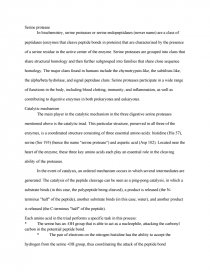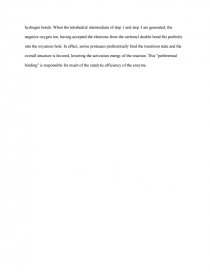Ms.
Essay by 24 • November 27, 2010 • 704 Words (3 Pages) • 1,042 Views
Serine protease
In biochemistry, serine proteases or serine endopeptidases (newer name) are a class of peptidases (enzymes that cleave peptide bonds in proteins) that are characterised by the presence of a serine residue in the active center of the enzyme. Serine proteases are grouped into clans that share structural homology and then further subgrouped into families that share close sequence homology. The major clans found in humans include the chymotrypsin-like, the subtilisin-like, the alpha/beta hydrolase, and signal peptidase clans. Serine proteases participate in a wide range of functions in the body, including blood clotting, immunity, and inflammation, as well as contributing to digestive enzymes in both prokaryotes and eukaryotes.
Catalytic mechanism
The main player in the catalytic mechanism in the three digestive serine proteases mentioned above is the catalytic triad. This particular structure, preserved in all three of the enzymes, is a coordinated structure consisting of three essential amino acids: histidine (His 57), serine (Ser 195) (hence the name "serine protease") and aspartic acid (Asp 102). Located near the heart of the enzyme, these three key amino acids each play an essential role in the cleaving ability of the proteases.
In the event of catalysis, an ordered mechanism occurs in which several intermediates are generated. The catalysis of the peptide cleavage can be seen as a ping-pong catalysis, in which a substrate binds (in this case, the polypeptide being cleaved), a product is released (the N-terminus "half" of the peptide), another substrate binds (in this case, water), and another product is released (the C-terminus "half" of the peptide).
Each amino acid in the triad performs a specific task in this process:
* The serine has an -OH group that is able to act as a nucleophile, attacking the carbonyl carbon in the potential peptide bond.
* The pair of electrons on the nitrogen histidine has the ability to accept the hydrogen from the serine -OH group, thus coordinating the attack of the peptide bond
* The carboxylic group on the aspartic acid in turn hydrogen bonds with the histidine, making the pair of electrons mentioned above much more electronegative.
The whole reaction can be summarized as follows:
* As the polypeptide enters, the above described process occurs: the serine -OH attacks the carbonyl carbon, the nitrogen of the histidine accepts the hydrogen from the -OH of the [serine] and a pair of electrons from the double bond of the carbonyl oxygen moves to the oxygen. As a result, a tetrahedral intermediate is generated.
* The bond joining the nitrogen and the carbon in the peptide bond is now broken. The covalent electrons creating this bond move to attack the hydrogen of the histidine, breaking the connection. The electrons that previously moved from the carbonyl oxygen double bond move back from the negative oxygen to recreate the bond, generating an acyl-enzyme intermediate.
...
...


